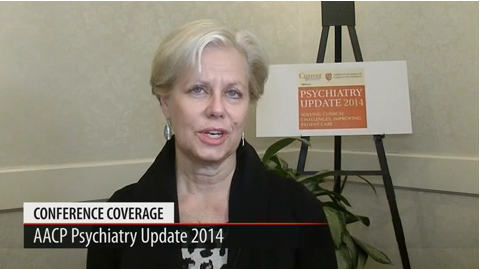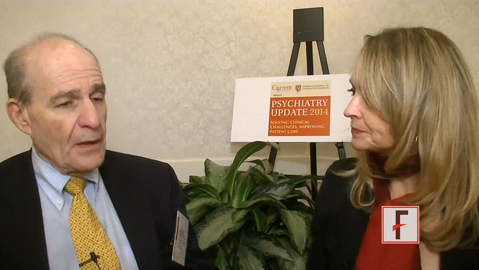User login
AUDIO: Chemotherapy toxicities masquerade as skin disease
PALM BEACH, ARUBA – Chemotherapy can trigger a host of skin presentations, the specific histologies of which may not be as recognizable to oncologists and hematologists as they would be to dermatologists and primary care physicians. Dr. Jean L. Bolognia, professor of dermatology and vice chair of clinical affairs at Yale University, New Haven, Conn., suggests that by using the all-encompassing clinical term "toxic erythema of chemotherapy," a common ground can be established between all members of a patient’s cancer treatment team, and better outcomes achieved.
In this podcast, Dr. Bolognia offers clinicians specifics for determining when a patient is experiencing a cutaneous reaction to chemotherapy or biologics vs. other skin diseases, and suggests ways to adjust treatment to lessen skin reactions. "It requires adjusting some of the misconceptions about drug eruptions," advises Dr. Bolognia. "This is a toxic reaction, not an allergic one." The distinction is important, according to Dr. Bolognia, especially if the patient is responding to their primary treatment; rather than stop a medication, the timing and dosage can be changed.
Among other tips, such as which drugs create certain drug eruptions, Dr. Bolognia reminds dermatologists and primary care clinicians including physician’s assistants that even a month after treatment, cutaneous reactions are possible.
On Twitter @whitneymcknight
PALM BEACH, ARUBA – Chemotherapy can trigger a host of skin presentations, the specific histologies of which may not be as recognizable to oncologists and hematologists as they would be to dermatologists and primary care physicians. Dr. Jean L. Bolognia, professor of dermatology and vice chair of clinical affairs at Yale University, New Haven, Conn., suggests that by using the all-encompassing clinical term "toxic erythema of chemotherapy," a common ground can be established between all members of a patient’s cancer treatment team, and better outcomes achieved.
In this podcast, Dr. Bolognia offers clinicians specifics for determining when a patient is experiencing a cutaneous reaction to chemotherapy or biologics vs. other skin diseases, and suggests ways to adjust treatment to lessen skin reactions. "It requires adjusting some of the misconceptions about drug eruptions," advises Dr. Bolognia. "This is a toxic reaction, not an allergic one." The distinction is important, according to Dr. Bolognia, especially if the patient is responding to their primary treatment; rather than stop a medication, the timing and dosage can be changed.
Among other tips, such as which drugs create certain drug eruptions, Dr. Bolognia reminds dermatologists and primary care clinicians including physician’s assistants that even a month after treatment, cutaneous reactions are possible.
On Twitter @whitneymcknight
PALM BEACH, ARUBA – Chemotherapy can trigger a host of skin presentations, the specific histologies of which may not be as recognizable to oncologists and hematologists as they would be to dermatologists and primary care physicians. Dr. Jean L. Bolognia, professor of dermatology and vice chair of clinical affairs at Yale University, New Haven, Conn., suggests that by using the all-encompassing clinical term "toxic erythema of chemotherapy," a common ground can be established between all members of a patient’s cancer treatment team, and better outcomes achieved.
In this podcast, Dr. Bolognia offers clinicians specifics for determining when a patient is experiencing a cutaneous reaction to chemotherapy or biologics vs. other skin diseases, and suggests ways to adjust treatment to lessen skin reactions. "It requires adjusting some of the misconceptions about drug eruptions," advises Dr. Bolognia. "This is a toxic reaction, not an allergic one." The distinction is important, according to Dr. Bolognia, especially if the patient is responding to their primary treatment; rather than stop a medication, the timing and dosage can be changed.
Among other tips, such as which drugs create certain drug eruptions, Dr. Bolognia reminds dermatologists and primary care clinicians including physician’s assistants that even a month after treatment, cutaneous reactions are possible.
On Twitter @whitneymcknight
EXPERT ANALYSIS FROM CARIBBEAN DERMATOLOGY SYMPOSIUM 2014
When Teen ‘Acting out’ Becomes Pathological
CHICAGO – How does a primary care doctor know when an adolescent patient’s unruliness has crossed the line into pathology? Dr. Jon E. Grant of the University of Chicago presented clinical perspectives about this and other aspects of what he called "disorders of impulsivity" at Psychiatry Update 2014, sponsored by Current Psychiatry and the American Academy of Clinical Psychiatrists.
"This is always the argument: ‘What separates out poorly mannered, poorly behaved people, compared to people with a disorder? ’ " Dr. Grant said in an interview. "It’s a constellation of symptoms, and the intensity and frequency of the symptoms."
Many pediatricians and family physicians might not be aware of how a patient’s predilection for pyromania or kleptomania also could indicate deeper troubles along the impulsivity spectrum. Dr. Grant offered advice on counseling these patients and their families and on when to refer them to a psychiatrist.
Current Psychiatry and this news organization are owned by the same parent company. Dr. Grant disclosed that he has relationships with Forest Pharmaceuticals, Roche, and Lundbeck.
On Twitter @whitneymcknight
The video associated with this article is no longer available on this site. Please view all of our videos on the MDedge YouTube channel
CHICAGO – How does a primary care doctor know when an adolescent patient’s unruliness has crossed the line into pathology? Dr. Jon E. Grant of the University of Chicago presented clinical perspectives about this and other aspects of what he called "disorders of impulsivity" at Psychiatry Update 2014, sponsored by Current Psychiatry and the American Academy of Clinical Psychiatrists.
"This is always the argument: ‘What separates out poorly mannered, poorly behaved people, compared to people with a disorder? ’ " Dr. Grant said in an interview. "It’s a constellation of symptoms, and the intensity and frequency of the symptoms."
Many pediatricians and family physicians might not be aware of how a patient’s predilection for pyromania or kleptomania also could indicate deeper troubles along the impulsivity spectrum. Dr. Grant offered advice on counseling these patients and their families and on when to refer them to a psychiatrist.
Current Psychiatry and this news organization are owned by the same parent company. Dr. Grant disclosed that he has relationships with Forest Pharmaceuticals, Roche, and Lundbeck.
On Twitter @whitneymcknight
The video associated with this article is no longer available on this site. Please view all of our videos on the MDedge YouTube channel
CHICAGO – How does a primary care doctor know when an adolescent patient’s unruliness has crossed the line into pathology? Dr. Jon E. Grant of the University of Chicago presented clinical perspectives about this and other aspects of what he called "disorders of impulsivity" at Psychiatry Update 2014, sponsored by Current Psychiatry and the American Academy of Clinical Psychiatrists.
"This is always the argument: ‘What separates out poorly mannered, poorly behaved people, compared to people with a disorder? ’ " Dr. Grant said in an interview. "It’s a constellation of symptoms, and the intensity and frequency of the symptoms."
Many pediatricians and family physicians might not be aware of how a patient’s predilection for pyromania or kleptomania also could indicate deeper troubles along the impulsivity spectrum. Dr. Grant offered advice on counseling these patients and their families and on when to refer them to a psychiatrist.
Current Psychiatry and this news organization are owned by the same parent company. Dr. Grant disclosed that he has relationships with Forest Pharmaceuticals, Roche, and Lundbeck.
On Twitter @whitneymcknight
The video associated with this article is no longer available on this site. Please view all of our videos on the MDedge YouTube channel
EXPERT ANALYSIS FROM PSYCHIATRY UPDATE 2014
VIDEO: When teen ‘acting out’ becomes pathological
CHICAGO – How does a primary care doctor know when an adolescent patient’s unruliness has crossed the line into pathology? Dr. Jon E. Grant of the University of Chicago presented clinical perspectives about this and other aspects of what he called "disorders of impulsivity" at Psychiatry Update 2014, sponsored by Current Psychiatry and the American Academy of Clinical Psychiatrists.
"This is always the argument: ‘What separates out poorly mannered, poorly behaved people, compared to people with a disorder? ’ " Dr. Grant said in an interview. "It’s a constellation of symptoms, and the intensity and frequency of the symptoms."
Many pediatricians and family physicians might not be aware of how a patient’s predilection for pyromania or kleptomania also could indicate deeper troubles along the impulsivity spectrum. Dr. Grant offered advice on counseling these patients and their families and on when to refer them to a psychiatrist.
Current Psychiatry and this news organization are owned by the same parent company. Dr. Grant disclosed that he has relationships with Forest Pharmaceuticals, Roche, and Lundbeck.
On Twitter @whitneymcknight
The video associated with this article is no longer available on this site. Please view all of our videos on the MDedge YouTube channel
CHICAGO – How does a primary care doctor know when an adolescent patient’s unruliness has crossed the line into pathology? Dr. Jon E. Grant of the University of Chicago presented clinical perspectives about this and other aspects of what he called "disorders of impulsivity" at Psychiatry Update 2014, sponsored by Current Psychiatry and the American Academy of Clinical Psychiatrists.
"This is always the argument: ‘What separates out poorly mannered, poorly behaved people, compared to people with a disorder? ’ " Dr. Grant said in an interview. "It’s a constellation of symptoms, and the intensity and frequency of the symptoms."
Many pediatricians and family physicians might not be aware of how a patient’s predilection for pyromania or kleptomania also could indicate deeper troubles along the impulsivity spectrum. Dr. Grant offered advice on counseling these patients and their families and on when to refer them to a psychiatrist.
Current Psychiatry and this news organization are owned by the same parent company. Dr. Grant disclosed that he has relationships with Forest Pharmaceuticals, Roche, and Lundbeck.
On Twitter @whitneymcknight
The video associated with this article is no longer available on this site. Please view all of our videos on the MDedge YouTube channel
CHICAGO – How does a primary care doctor know when an adolescent patient’s unruliness has crossed the line into pathology? Dr. Jon E. Grant of the University of Chicago presented clinical perspectives about this and other aspects of what he called "disorders of impulsivity" at Psychiatry Update 2014, sponsored by Current Psychiatry and the American Academy of Clinical Psychiatrists.
"This is always the argument: ‘What separates out poorly mannered, poorly behaved people, compared to people with a disorder? ’ " Dr. Grant said in an interview. "It’s a constellation of symptoms, and the intensity and frequency of the symptoms."
Many pediatricians and family physicians might not be aware of how a patient’s predilection for pyromania or kleptomania also could indicate deeper troubles along the impulsivity spectrum. Dr. Grant offered advice on counseling these patients and their families and on when to refer them to a psychiatrist.
Current Psychiatry and this news organization are owned by the same parent company. Dr. Grant disclosed that he has relationships with Forest Pharmaceuticals, Roche, and Lundbeck.
On Twitter @whitneymcknight
The video associated with this article is no longer available on this site. Please view all of our videos on the MDedge YouTube channel
EXPERT ANALYSIS FROM PSYCHIATRY UPDATE 2014
VIDEO: Overcoming barriers to discussing sexual dysfunction
CHICAGO – "We’re often not very well educated in medical school or in our residencies about how to talk to patients about sexual functioning and dysfunction," according to Dr. Anita H. Clayton, the interim chair of psychiatry and neurobehavioral sciences, and David C. Wilson Professor of Psychiatry at the University of Virginia, Charlottesville.
"Very often we feel we don’t have time to talk about it [with patients]," Dr. Clayton adds in this video recorded during the 2014 Psychiatry Update sponsored by Current Psychiatry and the American Academy of Clinical Psychiatrists, where Dr. Clayton was a presenter.
Patients might schedule an appointment with a doctor to talk about one thing, but what they really hope to discuss is their sexual dysfunction, despite not quite knowing how to go about it. When a provider can overcome his or her own embarrassment about the topic, "Patients often open up very easily, and they really do want to talk," says Dr. Clayton, also professor of clinical obstetrics and gynecology at the university.
Hear how Dr. Clayton suggests providers approach the sensitive topic of sexual dysfunction to help their patients return to having a healthy sex life.
Current Psychiatry and this news organization are owned by the same parent company.
The video associated with this article is no longer available on this site. Please view all of our videos on the MDedge YouTube channel
On Twitter @whitneymcknight
CHICAGO – "We’re often not very well educated in medical school or in our residencies about how to talk to patients about sexual functioning and dysfunction," according to Dr. Anita H. Clayton, the interim chair of psychiatry and neurobehavioral sciences, and David C. Wilson Professor of Psychiatry at the University of Virginia, Charlottesville.
"Very often we feel we don’t have time to talk about it [with patients]," Dr. Clayton adds in this video recorded during the 2014 Psychiatry Update sponsored by Current Psychiatry and the American Academy of Clinical Psychiatrists, where Dr. Clayton was a presenter.
Patients might schedule an appointment with a doctor to talk about one thing, but what they really hope to discuss is their sexual dysfunction, despite not quite knowing how to go about it. When a provider can overcome his or her own embarrassment about the topic, "Patients often open up very easily, and they really do want to talk," says Dr. Clayton, also professor of clinical obstetrics and gynecology at the university.
Hear how Dr. Clayton suggests providers approach the sensitive topic of sexual dysfunction to help their patients return to having a healthy sex life.
Current Psychiatry and this news organization are owned by the same parent company.
The video associated with this article is no longer available on this site. Please view all of our videos on the MDedge YouTube channel
On Twitter @whitneymcknight
CHICAGO – "We’re often not very well educated in medical school or in our residencies about how to talk to patients about sexual functioning and dysfunction," according to Dr. Anita H. Clayton, the interim chair of psychiatry and neurobehavioral sciences, and David C. Wilson Professor of Psychiatry at the University of Virginia, Charlottesville.
"Very often we feel we don’t have time to talk about it [with patients]," Dr. Clayton adds in this video recorded during the 2014 Psychiatry Update sponsored by Current Psychiatry and the American Academy of Clinical Psychiatrists, where Dr. Clayton was a presenter.
Patients might schedule an appointment with a doctor to talk about one thing, but what they really hope to discuss is their sexual dysfunction, despite not quite knowing how to go about it. When a provider can overcome his or her own embarrassment about the topic, "Patients often open up very easily, and they really do want to talk," says Dr. Clayton, also professor of clinical obstetrics and gynecology at the university.
Hear how Dr. Clayton suggests providers approach the sensitive topic of sexual dysfunction to help their patients return to having a healthy sex life.
Current Psychiatry and this news organization are owned by the same parent company.
The video associated with this article is no longer available on this site. Please view all of our videos on the MDedge YouTube channel
On Twitter @whitneymcknight
EXPERT ANALYSIS FROM PSYCHIATRY UPDATE 2014
VIDEO: Insomnia is a marker for suicide and depression
CHICAGO – "Having insomnia increases the risk of suicidality," according to Thomas Roth, Ph.D., a speaker at this year’s Psychiatry Update 2014 sponsored by Current Psychiatry and the American Academy of Clinical Psychiatrists. "This is especially true in adolescents."
In this video, Dr. Roth of Henry Ford Hospital in Detroit discusses what primary care physicians can do to help manage the drastic impact insomnia can have on a person’s life, and he explores the relationship sleeplessness has with suicide and depression. He also discusses how insomnia can be triggered by a variety of medications, including beta-blockers.
Current Psychiatry and this news organization are owned by the same parent company.
The video associated with this article is no longer available on this site. Please view all of our videos on the MDedge YouTube channel
On Twitter @whitneymcknight
CHICAGO – "Having insomnia increases the risk of suicidality," according to Thomas Roth, Ph.D., a speaker at this year’s Psychiatry Update 2014 sponsored by Current Psychiatry and the American Academy of Clinical Psychiatrists. "This is especially true in adolescents."
In this video, Dr. Roth of Henry Ford Hospital in Detroit discusses what primary care physicians can do to help manage the drastic impact insomnia can have on a person’s life, and he explores the relationship sleeplessness has with suicide and depression. He also discusses how insomnia can be triggered by a variety of medications, including beta-blockers.
Current Psychiatry and this news organization are owned by the same parent company.
The video associated with this article is no longer available on this site. Please view all of our videos on the MDedge YouTube channel
On Twitter @whitneymcknight
CHICAGO – "Having insomnia increases the risk of suicidality," according to Thomas Roth, Ph.D., a speaker at this year’s Psychiatry Update 2014 sponsored by Current Psychiatry and the American Academy of Clinical Psychiatrists. "This is especially true in adolescents."
In this video, Dr. Roth of Henry Ford Hospital in Detroit discusses what primary care physicians can do to help manage the drastic impact insomnia can have on a person’s life, and he explores the relationship sleeplessness has with suicide and depression. He also discusses how insomnia can be triggered by a variety of medications, including beta-blockers.
Current Psychiatry and this news organization are owned by the same parent company.
The video associated with this article is no longer available on this site. Please view all of our videos on the MDedge YouTube channel
On Twitter @whitneymcknight
EXPERT ANALYSIS FROM THE AACP 2014 PSYCHIATRY UPDATE MEETING
More conclusive link needed on teratogenicity and atypicals in pregnancy
CHICAGO – If you’re currently treating any pregnant patients who are taking atypical antipsychotics, Dr. Marlene P. Freeman and her colleagues, who’ve started a national registry for tracking these data, hope to hear from you.
"We also need information not just on patients who are taking antipsychotics but also on those who aren’t, so that we can expand the number of controls," Dr. Freeman said in an interview during Psychiatry Update 2014, cosponsored by the American Academy of Clinical Psychiatrists and Current Psychiatry.
"Our registry is carefully, prospectively done," said Dr. Freeman while speaking at the meeting. "It’s all done by phone, with two calls during pregnancy and one post partum."
Findings based on data collected before June 2013 and presented at a teratogenicity meeting last year were "not unblinded in terms of what medications were associated with what outcomes or who the controls were," she said. However, so far the trend is that antipsychotic use isn’t likely going to turn out to be as adverse as valproic acid, the anticonvulsant that ultimately was found associated with teratogenicity, said Dr. Freeman, who is the clinical director of Women’s Mental Health Center at Massachusetts General Hospital in Boston, where the registry is housed. "Rates of malformations [found in the registry data so far] were at or below the rates in the general population," she said, adding that definitive results are still needed.
At this time, more than 400 patients are enrolled in the registry, which began in 2011 in an effort to build a definitive database on teratogenicity and atypicals in pregnancy. According to Dr. Freeman, a German study published recently showed no significant difference between rates of major malformations between those exposed to first-generation antipsychotics or second-generation atypicals during the first trimester (J. Clin. Psychopharm. 2013;33:453-62). However, compared with controls, the major malformation rate was just over two times greater among those exposed to atypicals.
Meanwhile, a prospective Canadian study also cited by Dr. Freeman did not find a significant difference in congenital malformations between children born to mothers taking atypicals, compared with controls (BMJ Open 2013;3:e003062 [doi:10.1136/bmjopen-2013-003062]).
According to Dr. Freeman, the need for clear, substantial data is important, because the use of atypicals in pregnancy is on the rise. A study published last year and cited by Dr. Freeman found that among 585,615 U.S. deliveries that occurred during 2001-2007 with prescriptions dispensed to the mother between 60 days before or on the date of delivery, 0.72% received an atypical antipsychotic and 0.09% received a typical antipsychotic (Arch. Womens Ment. Health 2013;16:149-57). There was a 2.5-fold increase in atypicals prescribed over the course of the study period. Depression was the most common mental health diagnosis (63%), followed by bipolar disorder (43%), and schizophrenia (13%).
Dr. Freeman disclosed she has industry relationships with GlaxoSmithKline, Takeda/Lundbeck, and Genentech, among others. Current Psychiatry and this news organization are owned by the same parent company.
For more information on the National Pregnancy Registry, click here.
On Twitter @whitneymcknight
CHICAGO – If you’re currently treating any pregnant patients who are taking atypical antipsychotics, Dr. Marlene P. Freeman and her colleagues, who’ve started a national registry for tracking these data, hope to hear from you.
"We also need information not just on patients who are taking antipsychotics but also on those who aren’t, so that we can expand the number of controls," Dr. Freeman said in an interview during Psychiatry Update 2014, cosponsored by the American Academy of Clinical Psychiatrists and Current Psychiatry.
"Our registry is carefully, prospectively done," said Dr. Freeman while speaking at the meeting. "It’s all done by phone, with two calls during pregnancy and one post partum."
Findings based on data collected before June 2013 and presented at a teratogenicity meeting last year were "not unblinded in terms of what medications were associated with what outcomes or who the controls were," she said. However, so far the trend is that antipsychotic use isn’t likely going to turn out to be as adverse as valproic acid, the anticonvulsant that ultimately was found associated with teratogenicity, said Dr. Freeman, who is the clinical director of Women’s Mental Health Center at Massachusetts General Hospital in Boston, where the registry is housed. "Rates of malformations [found in the registry data so far] were at or below the rates in the general population," she said, adding that definitive results are still needed.
At this time, more than 400 patients are enrolled in the registry, which began in 2011 in an effort to build a definitive database on teratogenicity and atypicals in pregnancy. According to Dr. Freeman, a German study published recently showed no significant difference between rates of major malformations between those exposed to first-generation antipsychotics or second-generation atypicals during the first trimester (J. Clin. Psychopharm. 2013;33:453-62). However, compared with controls, the major malformation rate was just over two times greater among those exposed to atypicals.
Meanwhile, a prospective Canadian study also cited by Dr. Freeman did not find a significant difference in congenital malformations between children born to mothers taking atypicals, compared with controls (BMJ Open 2013;3:e003062 [doi:10.1136/bmjopen-2013-003062]).
According to Dr. Freeman, the need for clear, substantial data is important, because the use of atypicals in pregnancy is on the rise. A study published last year and cited by Dr. Freeman found that among 585,615 U.S. deliveries that occurred during 2001-2007 with prescriptions dispensed to the mother between 60 days before or on the date of delivery, 0.72% received an atypical antipsychotic and 0.09% received a typical antipsychotic (Arch. Womens Ment. Health 2013;16:149-57). There was a 2.5-fold increase in atypicals prescribed over the course of the study period. Depression was the most common mental health diagnosis (63%), followed by bipolar disorder (43%), and schizophrenia (13%).
Dr. Freeman disclosed she has industry relationships with GlaxoSmithKline, Takeda/Lundbeck, and Genentech, among others. Current Psychiatry and this news organization are owned by the same parent company.
For more information on the National Pregnancy Registry, click here.
On Twitter @whitneymcknight
CHICAGO – If you’re currently treating any pregnant patients who are taking atypical antipsychotics, Dr. Marlene P. Freeman and her colleagues, who’ve started a national registry for tracking these data, hope to hear from you.
"We also need information not just on patients who are taking antipsychotics but also on those who aren’t, so that we can expand the number of controls," Dr. Freeman said in an interview during Psychiatry Update 2014, cosponsored by the American Academy of Clinical Psychiatrists and Current Psychiatry.
"Our registry is carefully, prospectively done," said Dr. Freeman while speaking at the meeting. "It’s all done by phone, with two calls during pregnancy and one post partum."
Findings based on data collected before June 2013 and presented at a teratogenicity meeting last year were "not unblinded in terms of what medications were associated with what outcomes or who the controls were," she said. However, so far the trend is that antipsychotic use isn’t likely going to turn out to be as adverse as valproic acid, the anticonvulsant that ultimately was found associated with teratogenicity, said Dr. Freeman, who is the clinical director of Women’s Mental Health Center at Massachusetts General Hospital in Boston, where the registry is housed. "Rates of malformations [found in the registry data so far] were at or below the rates in the general population," she said, adding that definitive results are still needed.
At this time, more than 400 patients are enrolled in the registry, which began in 2011 in an effort to build a definitive database on teratogenicity and atypicals in pregnancy. According to Dr. Freeman, a German study published recently showed no significant difference between rates of major malformations between those exposed to first-generation antipsychotics or second-generation atypicals during the first trimester (J. Clin. Psychopharm. 2013;33:453-62). However, compared with controls, the major malformation rate was just over two times greater among those exposed to atypicals.
Meanwhile, a prospective Canadian study also cited by Dr. Freeman did not find a significant difference in congenital malformations between children born to mothers taking atypicals, compared with controls (BMJ Open 2013;3:e003062 [doi:10.1136/bmjopen-2013-003062]).
According to Dr. Freeman, the need for clear, substantial data is important, because the use of atypicals in pregnancy is on the rise. A study published last year and cited by Dr. Freeman found that among 585,615 U.S. deliveries that occurred during 2001-2007 with prescriptions dispensed to the mother between 60 days before or on the date of delivery, 0.72% received an atypical antipsychotic and 0.09% received a typical antipsychotic (Arch. Womens Ment. Health 2013;16:149-57). There was a 2.5-fold increase in atypicals prescribed over the course of the study period. Depression was the most common mental health diagnosis (63%), followed by bipolar disorder (43%), and schizophrenia (13%).
Dr. Freeman disclosed she has industry relationships with GlaxoSmithKline, Takeda/Lundbeck, and Genentech, among others. Current Psychiatry and this news organization are owned by the same parent company.
For more information on the National Pregnancy Registry, click here.
On Twitter @whitneymcknight
EXPERT ANALYSIS FROM PSYCHIATRY UPDATE 2014
FDA approves Ragwitek, third sublingual allergy med in a month
The Food and Drug Administration has approved Ragwitek, a sublingual treatment for short ragweed pollen–related allergic rhinitis in people aged 18-65 years.
This is the first FDA-approved oral therapy for hay fever, with or without conjunctivitis, and the third oral allergy medication approved by the FDA in less than a month. On April 1, the agency green-lighted Oralair for the treatment of gross pollen-related allergies in persons aged 10-65 years. On April 15, Grastek earned approval as an oral treatment for grass pollen allergy in people aged 5-65 years.
The approval offers "millions of adults living with ragweed-pollen allergies in the United States an alternative to allergy shots to help manage their disease," Dr. Karen Midthun, director of the FDA’s Center for Biologics Evaluation and Research, said in a statement. Other treatments include avoiding the allergen and medications to treat symptoms.
Ragwitek contains traces of pollen from the short ragweed (Ambrosia artemisiifolia) plant, and is administered as a quick-dissolving tablet placed once daily under the tongue. Treatment begins 12 weeks before the ragweed pollen season begins in late summer/early fall, and continues throughout the season. The first dose of the therapy is taken under observation by a health care provider. If no adverse reaction is noted after 30 minutes, the patient self-administers the medication thereafter.
Ragwitek’s safety was assessed in approximately 1,700 adults. The most common adverse reactions included itching in the mouth and ears and some throat irritation. Among those patients, 760 were evaluated to determine the therapy’s efficacy. Those assigned to Ragwitek reported about a 26% reduction in symptoms, compared with those who took placebo.
A black box warning accompanies the treatment, cautioning that life-threatening, severe allergic reactions are possible. A self-injected dose of epinephrine is recommended if needed.
Catalent Pharma Solutions manufactures Ragwitek for Merck, Sharp & Dohme.
On Twitter @whitneymcknight
The Food and Drug Administration has approved Ragwitek, a sublingual treatment for short ragweed pollen–related allergic rhinitis in people aged 18-65 years.
This is the first FDA-approved oral therapy for hay fever, with or without conjunctivitis, and the third oral allergy medication approved by the FDA in less than a month. On April 1, the agency green-lighted Oralair for the treatment of gross pollen-related allergies in persons aged 10-65 years. On April 15, Grastek earned approval as an oral treatment for grass pollen allergy in people aged 5-65 years.
The approval offers "millions of adults living with ragweed-pollen allergies in the United States an alternative to allergy shots to help manage their disease," Dr. Karen Midthun, director of the FDA’s Center for Biologics Evaluation and Research, said in a statement. Other treatments include avoiding the allergen and medications to treat symptoms.
Ragwitek contains traces of pollen from the short ragweed (Ambrosia artemisiifolia) plant, and is administered as a quick-dissolving tablet placed once daily under the tongue. Treatment begins 12 weeks before the ragweed pollen season begins in late summer/early fall, and continues throughout the season. The first dose of the therapy is taken under observation by a health care provider. If no adverse reaction is noted after 30 minutes, the patient self-administers the medication thereafter.
Ragwitek’s safety was assessed in approximately 1,700 adults. The most common adverse reactions included itching in the mouth and ears and some throat irritation. Among those patients, 760 were evaluated to determine the therapy’s efficacy. Those assigned to Ragwitek reported about a 26% reduction in symptoms, compared with those who took placebo.
A black box warning accompanies the treatment, cautioning that life-threatening, severe allergic reactions are possible. A self-injected dose of epinephrine is recommended if needed.
Catalent Pharma Solutions manufactures Ragwitek for Merck, Sharp & Dohme.
On Twitter @whitneymcknight
The Food and Drug Administration has approved Ragwitek, a sublingual treatment for short ragweed pollen–related allergic rhinitis in people aged 18-65 years.
This is the first FDA-approved oral therapy for hay fever, with or without conjunctivitis, and the third oral allergy medication approved by the FDA in less than a month. On April 1, the agency green-lighted Oralair for the treatment of gross pollen-related allergies in persons aged 10-65 years. On April 15, Grastek earned approval as an oral treatment for grass pollen allergy in people aged 5-65 years.
The approval offers "millions of adults living with ragweed-pollen allergies in the United States an alternative to allergy shots to help manage their disease," Dr. Karen Midthun, director of the FDA’s Center for Biologics Evaluation and Research, said in a statement. Other treatments include avoiding the allergen and medications to treat symptoms.
Ragwitek contains traces of pollen from the short ragweed (Ambrosia artemisiifolia) plant, and is administered as a quick-dissolving tablet placed once daily under the tongue. Treatment begins 12 weeks before the ragweed pollen season begins in late summer/early fall, and continues throughout the season. The first dose of the therapy is taken under observation by a health care provider. If no adverse reaction is noted after 30 minutes, the patient self-administers the medication thereafter.
Ragwitek’s safety was assessed in approximately 1,700 adults. The most common adverse reactions included itching in the mouth and ears and some throat irritation. Among those patients, 760 were evaluated to determine the therapy’s efficacy. Those assigned to Ragwitek reported about a 26% reduction in symptoms, compared with those who took placebo.
A black box warning accompanies the treatment, cautioning that life-threatening, severe allergic reactions are possible. A self-injected dose of epinephrine is recommended if needed.
Catalent Pharma Solutions manufactures Ragwitek for Merck, Sharp & Dohme.
On Twitter @whitneymcknight
AUDIO: Beyond the battlefield: suicide, PTSD, and ‘moral injury’
Military suicide rates for never-deployed service members now surpass rates for those who have been in-country. Is one of the reasons because veterans who’ve served don’t make the time to help welcome new recruits into the fold, leaving them to feel isolated and not a part of the mission?
"The Army itself has been on a very high operations tempo. Troops are deploying all the time. They’re tired," says Col. Elspeth Cameron Ritchie, U.S. Army retired, and a former Army psychiatrist. "When a new solder joins a unit, [he or she] may not be welcomed in the same way as [a soldier] might have been in the past."
But, does the military attract people who are already predisposed to mental health issues, including suicidal ideation? And while most servicemen and -women are sound of mind and body when they start out, if they do encounter mental health issues, many don’t seek the help that is available to them.
In this audio interview, Dr. Ritchie explains why this may be the case, and examines the role stigma does – or doesn’t – play in addressing mental health issues in the military. She also defines what is only now beginning to receive recognition as a factor in posttraumatic stress disorder: moral injury, or the effects of having to kill on order.
Dr. Ritchie also discussed how PTSD entered our lexicon and what utility the diagnosis has for nonservice members.
On Twitter @whitneymcknight
Military suicide rates for never-deployed service members now surpass rates for those who have been in-country. Is one of the reasons because veterans who’ve served don’t make the time to help welcome new recruits into the fold, leaving them to feel isolated and not a part of the mission?
"The Army itself has been on a very high operations tempo. Troops are deploying all the time. They’re tired," says Col. Elspeth Cameron Ritchie, U.S. Army retired, and a former Army psychiatrist. "When a new solder joins a unit, [he or she] may not be welcomed in the same way as [a soldier] might have been in the past."
But, does the military attract people who are already predisposed to mental health issues, including suicidal ideation? And while most servicemen and -women are sound of mind and body when they start out, if they do encounter mental health issues, many don’t seek the help that is available to them.
In this audio interview, Dr. Ritchie explains why this may be the case, and examines the role stigma does – or doesn’t – play in addressing mental health issues in the military. She also defines what is only now beginning to receive recognition as a factor in posttraumatic stress disorder: moral injury, or the effects of having to kill on order.
Dr. Ritchie also discussed how PTSD entered our lexicon and what utility the diagnosis has for nonservice members.
On Twitter @whitneymcknight
Military suicide rates for never-deployed service members now surpass rates for those who have been in-country. Is one of the reasons because veterans who’ve served don’t make the time to help welcome new recruits into the fold, leaving them to feel isolated and not a part of the mission?
"The Army itself has been on a very high operations tempo. Troops are deploying all the time. They’re tired," says Col. Elspeth Cameron Ritchie, U.S. Army retired, and a former Army psychiatrist. "When a new solder joins a unit, [he or she] may not be welcomed in the same way as [a soldier] might have been in the past."
But, does the military attract people who are already predisposed to mental health issues, including suicidal ideation? And while most servicemen and -women are sound of mind and body when they start out, if they do encounter mental health issues, many don’t seek the help that is available to them.
In this audio interview, Dr. Ritchie explains why this may be the case, and examines the role stigma does – or doesn’t – play in addressing mental health issues in the military. She also defines what is only now beginning to receive recognition as a factor in posttraumatic stress disorder: moral injury, or the effects of having to kill on order.
Dr. Ritchie also discussed how PTSD entered our lexicon and what utility the diagnosis has for nonservice members.
On Twitter @whitneymcknight
VIDEO: Some SSRIs are better than others for pregnant women
CHICAGO – The Food and Drug Administration’s letter rating scale is "unreliable" when it comes to prescribing antidepressants for pregnant women, according to Dr. Marlene P. Freeman, director of clinical services for the perinatal and reproductive psychiatry clinical research program at Massachusetts General Hospital in Boston.
"It’s actually very important to disregard those letters and turn to actual data when making clinical decisions, which can be very difficult for the individual practitioner who doesn’t specialize in this area," Dr. Freeman said in an interview during Psychiatry Update 2014, sponsored by Current Psychiatry and the American Academy of Clinical Psychiatrists.
Other concerns Dr. Freeman thinks clinicians treating pregnant women with depression need to be aware of include which SSRIs can lead to cardiovascular malformations in the child, as well as which ones have been associated with spontaneous abortions. Dr. Freeman also discusses what supplementation offers promise for preventing autism, and when omega-3 fatty acid supplementation is appropriate for first-line therapy in depression.
Current Psychiatry and this news organization are owned by the same parent company.
The video associated with this article is no longer available on this site. Please view all of our videos on the MDedge YouTube channel
On Twitter @whitneymcknight
CHICAGO – The Food and Drug Administration’s letter rating scale is "unreliable" when it comes to prescribing antidepressants for pregnant women, according to Dr. Marlene P. Freeman, director of clinical services for the perinatal and reproductive psychiatry clinical research program at Massachusetts General Hospital in Boston.
"It’s actually very important to disregard those letters and turn to actual data when making clinical decisions, which can be very difficult for the individual practitioner who doesn’t specialize in this area," Dr. Freeman said in an interview during Psychiatry Update 2014, sponsored by Current Psychiatry and the American Academy of Clinical Psychiatrists.
Other concerns Dr. Freeman thinks clinicians treating pregnant women with depression need to be aware of include which SSRIs can lead to cardiovascular malformations in the child, as well as which ones have been associated with spontaneous abortions. Dr. Freeman also discusses what supplementation offers promise for preventing autism, and when omega-3 fatty acid supplementation is appropriate for first-line therapy in depression.
Current Psychiatry and this news organization are owned by the same parent company.
The video associated with this article is no longer available on this site. Please view all of our videos on the MDedge YouTube channel
On Twitter @whitneymcknight
CHICAGO – The Food and Drug Administration’s letter rating scale is "unreliable" when it comes to prescribing antidepressants for pregnant women, according to Dr. Marlene P. Freeman, director of clinical services for the perinatal and reproductive psychiatry clinical research program at Massachusetts General Hospital in Boston.
"It’s actually very important to disregard those letters and turn to actual data when making clinical decisions, which can be very difficult for the individual practitioner who doesn’t specialize in this area," Dr. Freeman said in an interview during Psychiatry Update 2014, sponsored by Current Psychiatry and the American Academy of Clinical Psychiatrists.
Other concerns Dr. Freeman thinks clinicians treating pregnant women with depression need to be aware of include which SSRIs can lead to cardiovascular malformations in the child, as well as which ones have been associated with spontaneous abortions. Dr. Freeman also discusses what supplementation offers promise for preventing autism, and when omega-3 fatty acid supplementation is appropriate for first-line therapy in depression.
Current Psychiatry and this news organization are owned by the same parent company.
The video associated with this article is no longer available on this site. Please view all of our videos on the MDedge YouTube channel
On Twitter @whitneymcknight
EXPERT ANALYSIS FROM PSYCHIATRY UPDATE 2014
AUDIO: The 'moral injury' suffered after killing on command
How does killing another person because you’ve been commanded to affect one’s mental health? Does it bring on an existential crisis, and does that contribute to posttraumatic stress disorder?
Col. Elspeth Ritchie, U.S. Army retired and an Army psychiatrist, explains how participating in "vast amounts of death and destruction" affects a person’s ability to cope afterward.
On Twitter @whitneymcknight
How does killing another person because you’ve been commanded to affect one’s mental health? Does it bring on an existential crisis, and does that contribute to posttraumatic stress disorder?
Col. Elspeth Ritchie, U.S. Army retired and an Army psychiatrist, explains how participating in "vast amounts of death and destruction" affects a person’s ability to cope afterward.
On Twitter @whitneymcknight
How does killing another person because you’ve been commanded to affect one’s mental health? Does it bring on an existential crisis, and does that contribute to posttraumatic stress disorder?
Col. Elspeth Ritchie, U.S. Army retired and an Army psychiatrist, explains how participating in "vast amounts of death and destruction" affects a person’s ability to cope afterward.
On Twitter @whitneymcknight
EXPERT ANALYSIS FROM CLINICAL PSYCHIATRY NEWS BOARD MEMBER









